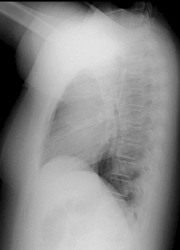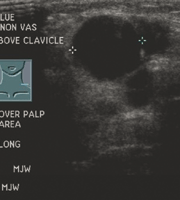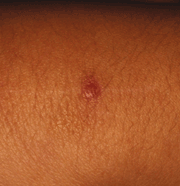12-year-old female referred for evaluation of left supraclavicular swelling
Click Here to Manage Email Alerts
A 12-year-old female was referred to the pediatric infectious disease clinic for evaluation of left supraclavicular swelling. The onset was about 3 weeks earlier when painless swelling was noted along with a papular lesion overlying the area. She and her parents denied any preceding injury, including scratches prior to noticing the swelling, but did note that a similar papular lesion had appeared on her left forearm at about the same time that subsequently resolved. There was no fever, but there was some concern for a possible 1-2 lbs. weight loss. However, the parents attribute this to some diarrhea that began soon after empiric antimicrobial therapy was started with Trimethoprim/sulfamethoxazole for possible Staphylococcus aureus infection. The lesion never drained, but has grown in size since the onset.
She denies any other symptoms, such as nausea, vomiting, cough, congestion, rash, night sweats or chills. She remained feeling as well as usual. There has been no travel in more than a year, and no sick visitors or other sick contacts of which they are aware. Her immunizations are up to date. Animal exposure includes a 2- to 3-year-old cat that had kittens about 9 months earlier. The kittens were eventually given away, but she did admit to playing with all the cats, but rarely got scratched. Other animal contacts include two healthy family dogs.
Her past medical history is that of a healthy pre-adolescent female.
Examination revealed a mildly obese female in no distress, with normal vital signs. Her exam was otherwise positive only for a palpable, painless left supraclavicular mass measuring 4 x 3 cm with an overlying, somewhat umbilicated papule measuring about 6 mm as shown in Figures 1-2. The rest of her exam was completely normal for her age.
 |
 |
|
Figs 1, 2: A painless supraclavicular mass
measuring 4 cm x 3 cm with an overlying somewhat umbilicated papule measuring about 6 mm. |
|
Lab tests done 1 week before the visit included a normal CBC, negative cat scratch titers and normal ESR. A chest radiograph is done during the consult visit and is shown in Figures 3-4. The above lab tests were repeated with a fungal panel, a metabolic profile and C-reactive protein added along with placing a PPD at the end of the consult visit. An ultrasound was done prior to leaving the clinic (Figure 5) and she was empirically treated with azithromycin at a dose of 600 mg orally once a day for 10 days.
 |
 |
|
Figs 3, 4: A plain chest radiograph showing
normal results. |
|
 |
|
Figure 5: Results of an ultrasound reveal
hypoechogenic lesions that seem to be due to infection vs. hematologic
malignancy. |
What’s Your Diagnosis?
- Lymphoma
- MRSA lymphadenitis
- Mycobacteria lymphadenitis
- Cat scratch disease
This is one of those cases in which the answer is not certain, but in my opinion, the answer is sero-negative Cat scratch disease (D). The repeat testing was again normal or negative, as were the rest of the lab tests and PPD ordered. The plain chest radiograph was normal and the ultrasound shown in Figure 5 reveals “a few hypoechogenic lesions, the largest being 1.6 cm in diameter, c/w conglomerate lymphadenopathy most likely due to infection vs. lymphoma.” Follow-up 9 days later revealed significant shrinking of the mass and the papule, and 2 weeks after that, the mass was not palpable and the skin lesion was almost gone (Figure 6). Her weight had also come back to her previous level by the last visit. Therefore, with the complete normalization of the lymph node exam over the few weeks after beginning azithromycin, the course seemed not consistent with the other choices.

Vice Chair for Education at The Children’s Hospital at Scott
and White and Associate Professor of Pediatrics at Texas A&M University,
College of Medicine, Temple, Texas. E-mail: jhbrien@aol.com.
e-mail:jhbrien@aol.com
I think it would be very unusual for a staph infection of a lymph node that worsened on trimethoprim/sulfamethoxazole to resolve that readily with a 10 day course of azithromycin or any other oral therapy, and certainly an infection with mycobacteria would have likely worsened as well. I think the same could be said if this were a fungal infection; it just should not have gotten better that quick without treatment. Glandular or ulceroglandular tularemia may appear with similar findings, however, the infection is usually associated with a tick bite and more systemic symptoms such as fever and chills. If unsure about cat scratch or tularemia, one can choose to begin treatment with IV gentamicin until the diagnosis is clearer. Azithromycin was picked because of it being the only drug subjected to scientific testing in treating cat scratch disease (Bass JW. PIDJ. 1998;17:447-452).
 |
 |
|
Fig 6: Two weeks after treatment with azithromycin. The mass was not palpable and the lesion is gone. |
Fig 7: A cutaneous granuloma may not always be seen, but here is visible in the healing scratch. |
The cutaneous granuloma may not be seen, but usually appears within the first week after the infecting scratch and can be brief, but may last up to a couple of months, and may occasionally be seen within the healing scratch (Figure 7). Regarding the negative serology, it would be nice to have seen a positive, but negative Bartonella henselae serology has been occasionally reported in histologically proven cat scratch disease.
No test has 100% sensitivity.
Lymphoma was a concern initially, but when the lesion shrunk and the patient remained well with the weight loss being brief and explained, lymphoma seemed to be very unlikely. Plus, I’m not likely to show a lymphoma in this column; or would I?
Columnist Comments
I want to thank Stuart Coles, MD, of the Scott & White Department of Pediatrics for contributing this unusual case of presumed cat scratch disease.
In the August issue, I mentioned a brief seminar that was to be held on Oct. 22 and 23 at Tripler Army Medical Center in Honolulu to commemorate the dedication of the Pediatric Conference Room to James W. Bass. I’m happy to say it was a terrific experience and I think a very good CME activity. The occasion was made extra special by the presence of Beverly Bass, Col. Bass’ widow, as shown in Figure 8 with (from left to right) Lt. Col. Mark Burnett (current Pediatric Infectious Diseases Staff and responsible for the Books for Afghanistan Doctors Project), Larry Pickering of the CDC, myself, Russell Steele (a former Bass resident and current PID staff at Ochsner Clinic in New Orleans), Col. (Retired) Judy Vincent (a former Bass Fellow), Beverly Bass, Col. Marty Weisse (a former Bass Fellow and current department chairman) and Col. (Retired) Denise Demers (Jim Bass’ last fellow). Of those in the picture, Colonel’s Weisse, Vincent and Demers published numerous papers with Jim Bass on various aspects of cat scratch disease between the mid to late 1990s, adding significant understanding of this interesting infectious disease.
 |
|
Shown, from left, at a conference room
dedication to Col. James W. Bass at the Tripler Army Medical Center in
Honolulu: Lt. Col. Mark Burnett, Larry Pickering, James H. Brien, Russell
Steele, Col. Judy Vincent, Beverly Bass (James Bass’ widow), Col. Marty
Weisse and Col. Denise Demers. |
There is still much that is unknown about this common infectious disease, including its many manifestations, diagnosis and best treatment. Perhaps more work will come out of Hawaii, where CSD is common, to help add some clarity to these questions.
Images: Brien JH
